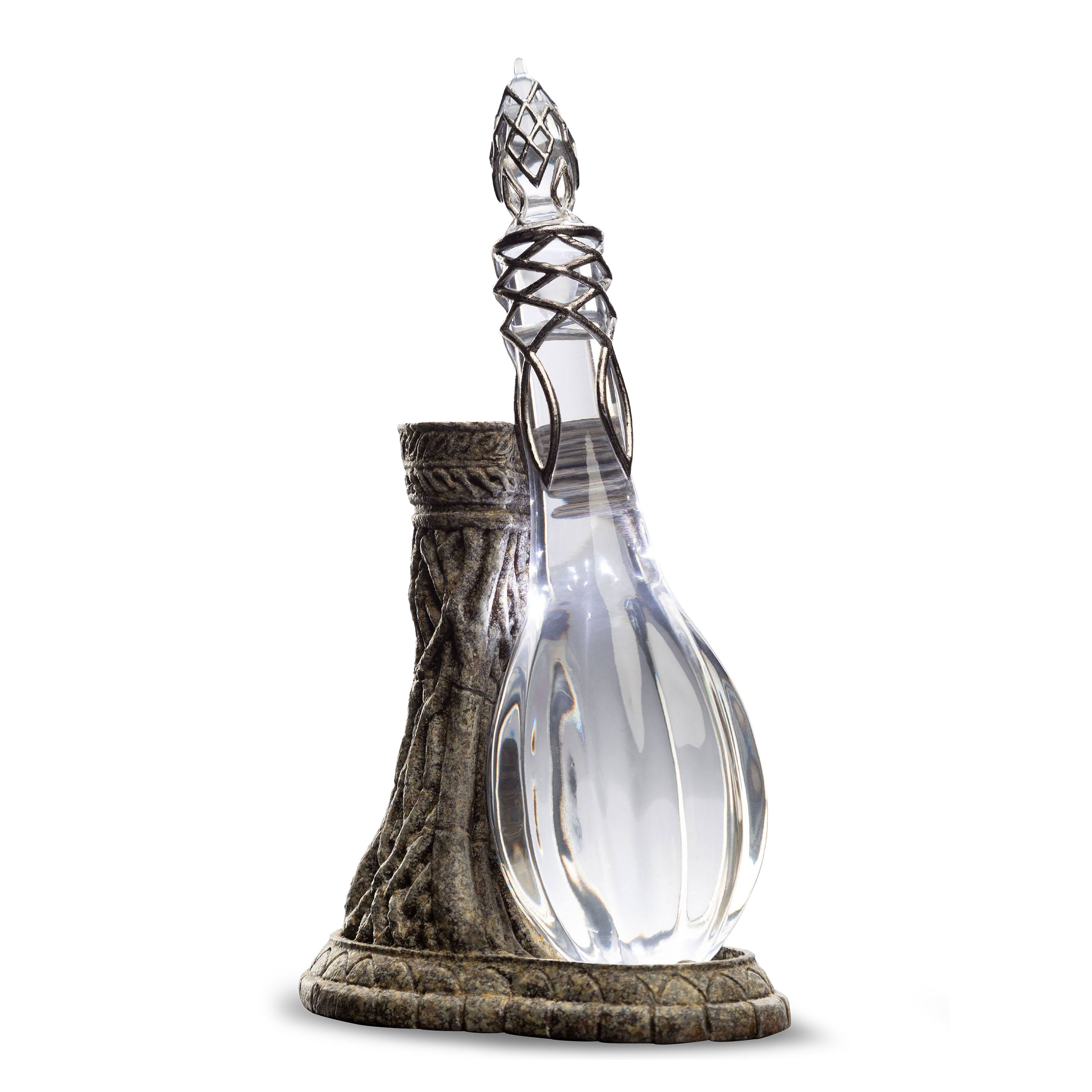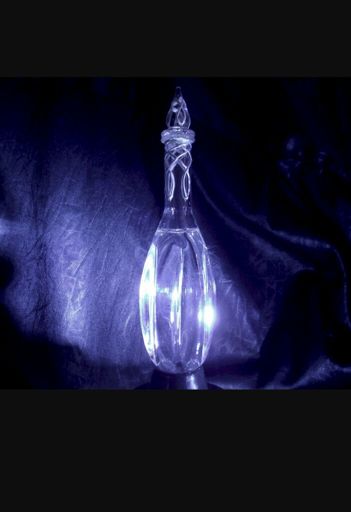The Phial of Galadriel is an object in J. R. R. Tolkien's epic fantasy The Lord of the Rings. It is a gift from the Elf-lady Galadriel to the protagonist Frodo Baggins, who uses its brilliant light at several critical moments during his journey to Mount Doom.
Tolkien added the Phial late in the writing of The Lord of the Rings; it appears only in his fifth version of the chapter "Farewell to Lothlórien".
The Tolkien scholar Verlyn Flieger describes the Phial as a splinter of the created light. This came ultimately from the Two Trees of Valinor, by way of a Silmaril made from their light, and then via Galadriel's fountain which captured a little of that Silmaril's light, shining as Eärendil's star. The Phial is one of the elements that associate the character of Galadriel with light, water, and Mary, mother of Jesus, indicating Galadriel's psychological pairing with the evil spider Shelob, symbolising light against darkness.
Narrative
The Phial of Galadriel is a small crystal bottle filled with water from Galadriel's fountain. It contains a little of the light of Eärendil's star. The mariner Eärendil is the holder of one of the three Silmarils preserving the light of the Two Trees of Valinor, and he travels the skies like a star aboard his ship, the Vingilot. When the Fellowship of the Ring leaves Lothlórien, Galadriel gives each of the nine an appropriate gift. To Frodo she offers the Phial, wishing him: "May it be a light to you in dark places, when all other lights go out." Frodo then wears it around his neck.
The hobbits Frodo and Sam use the Phial several times during their journey to Mordor. Sam calls it a "star-glass". On the steps of Cirith Ungol, when Frodo is chased by a Nazgûl, and is about to give in to the temptation to put on the One Ring and reveal himself to the enemy, he holds the Phial instead, which restores his senses. Later, its light helps the hobbits fight Shelob in her lair.
"... slowly he held aloft the Phial of Galadriel. ... then as its power waxed, and hope grew in Frodo’s mind, it began to burn, and kindled to a silver flame, a minute heart of dazzling light, as though Eärendil had himself come down from the high sunset paths with the last Silmaril upon his brow."
Sam uses the Phial to defeat the Watchers of the tower of Cirith Ungol. However, its power is no match for Sauron's; when the hobbits try to use it again as they approach Mount Doom, its light dims.
After destroying the Ring and Sauron, Frodo leaves Middle-earth from the Grey Havens. As he takes the Phial with him, its light fades and disappears while Sam watches from the Western shore.
Concept and creation
The Phial of Galadriel appears late in the writing of The Lord of the Rings. When J. R. R. Tolkien reached the chapter "Farewell to Lothlórien", he wrote four versions of the chapter without any mention of the Phial, although the distribution of gifts to other members of the Fellowship appears in the third version. It is only in the fifth version of the chapter that the Phial appears, in terms almost identical to those of the final text.
In a summary of events at the end of the story, its light enables Frodo, locked in the tower of Cirith Ungol, to see Sauron's forces massing at the Black Gate to face the approaching army of the West a hundred miles away. Christopher Tolkien, editing his father's mass of texts, comments: "Here the light of the Phial of Galadriel has considerable power, a true star in the darkness".
Analysis
A splinter of the created light
For the Tolkien scholar Verlyn Flieger in her book Splintered Light, light is a powerful symbol of divine creation. Little of that ancient light remains in the Third Age, but the Phial's light is a surviving fragment of the light of Eärendil's star. Flieger likens the Phial's stature to Frodo's: it is a splinter of the created light, just as Frodo is a "broken down" fragment of humanity. She suggests contrasting the Phial with the One Ring, as both are called "presents" or "gifts": the Phial is an object of light, the Ring an object of darkness.
For Rosalia Fernandez-Colmeiro, the Phial of Galadriel illustrates the relationship between water and light in Tolkien's work: the light of Eärendil's Silmaril is captured by the water of Galadriel's fountain. Likewise, with its origin in Lothlórien, a forest with axis mundi characteristics, and its power derived from a star, the Phial of Galadriel helps to establish The Lord of the Rings in a mythical space-time.
The Phial links the Third Age events of The Lord of the Rings to the tales of the Elder Days in The Silmarillion, as does Galadriel herself. The light of the Phial is a tiny part of the light of the vala Elbereth, who created the stars and blessed the Silmarils, and to whom Samwise appeals in the face of Shelob. In the end, the Phial is used to defeat Shelob, a descendant of Ungoliant, the monstrous servant of Morgoth who had destroyed the light-giving Two Trees of Valinor. The link with The Silmarillion is explicit, as Samwise Gamgee evokes Beren on the stairs of Cirith Ungol, shortly before meeting the spider. The Phial is effective not only because it contains the light of Valinor, but also because it is a "manifestation of history, of time fulfilled."
Light against darkness
For Marjorie Burns, the Phial of Galadriel is one of the elements that indicate the contrasting characters of Galadriel and Shelob: its light contrasts with the darkness of the spider.
In Burns's view, the Phial serves to bring Galadriel's character closer to the Irish goddess The Morrígan, who uses a pale, liquid potion contained in a glass phial.
Robert Steed writes that Tolkien "creatively adapts" the medieval theme of the Harrowing of Hell for several occasions in his legendarium where his protagonists parallel what was believed to be Christ's descent into Hell, setting the Devil's captives free with the irresistible power of his divine light. Steed comments that Sam was an "odd" fit for the pattern of the Christ-like irresistible force, but in the narrative he indeed plays the part of the "light-bearing liberator at the center of the Harrowing of Hell motif".
The Episcopal priest and Tolkien scholar Fleming Rutledge writes that in Sam's attack on Shelob, the light of the Phial of Galadriel "leapt as if 'from the firmament with intolerable light.'" She comments that Tolkien's choice of the word "firmament", with its Biblical ring, indicates the "divine presence", while the "intolerable light" recalls the overpowering light that blinded the Apostle Paul in the New Testament, and which lit up the face of the prophet Moses in the Old Testament.
Sarah Downey, in the journal Mythlore, likens Galadriel to a guide-figure such as Dante's Beatrice in his Divine Comedy, and the Phial "a continued guidance" for Frodo after he has left Lothlórien. Further, she notes that the Phial holds "the light of Eärendil's star, set amid the waters of my fountain", and that Sam voices Galadriel's association with both light and water. Downey comments that like Galadriel, the pearl-maiden in the medieval English poem Pearl is seen in white and gold, while Beatrice shimmers "clothed in the colour of a living flame". The light-bearing Phial, then, connects Galadriel with the celestial ladies of the Middle Ages.
Water of baptism
Jason Fisher draws a parallel between the water in the Phial and the Christian sacrament of baptism, noting that Tolkien recognized the similarities between the character of Galadriel and Mary, mother of Jesus. The Phial is akin to charismata, spiritual gifts, in line with Jesus's words in the Book of Revelation: "And he that overcometh, and keepeth my works unto the end, [...] I will give the Morning Star" (2:26–28); in Tolkien's legendarium, the Morning Star corresponds to the Silmaril carried by Eärendil, whose light the Phial captures. The Episcopal priest and Tolkien scholar Fleming Rutledge similarly comments that the Phial is "filled with baptismal water".
Adaptations
The Phial of Galadriel has been illustrated by Tolkien artists including John Howe, Anke Eißmann, and Ted Nasmith. The Phial appears in Peter Jackson's film trilogy, both in The Fellowship of the Ring where Galadriel presents Frodo with the gift, and in The Return of the King where Frodo and Sam use it to get through the Pass of Cirith Ungol, its light dazzling Shelob the giant spider. The prop was made in accordance with Tolkien's written description by Wētā Workshop. There are two Phial of Galadriel cards in the Lord of the Rings Trading Card Game.
References
Primary
Secondary
Sources
- Flieger, Verlyn (1983). Splintered Light: Logos and Language in Tolkien's World. Wm. B. Eerdmans. ISBN 978-0-8028-1955-0.
- Rutledge, Fleming (2004). The Battle for Middle-earth: Tolkien's Divine Design in The Lord of the Rings. Wm. B. Eerdmans. ISBN 978-0-8028-2497-4.
- Steed, Robert (2017). "The Harrowing of Hell Motif in Tolkien's Legendarium". Mallorn (58): 6–9.
- Tolkien, J. R. R. (1954a). The Fellowship of the Ring. The Lord of the Rings. Boston: Houghton Mifflin. OCLC 9552942.
- Tolkien, J. R. R. (1954). The Two Towers. The Lord of the Rings. Boston: Houghton Mifflin. OCLC 1042159111.
- Tolkien, J. R. R. (1955). The Return of the King. The Lord of the Rings. Boston: Houghton Mifflin. OCLC 519647821.
- Tolkien, J. R. R. (1977). Christopher Tolkien (ed.). The Silmarillion. Boston: Houghton Mifflin. ISBN 978-0-395-25730-2.
- Tolkien, J. R. R. (1989). Christopher Tolkien (ed.). The Treason of Isengard. Boston: Houghton Mifflin. ISBN 978-0-395-51562-4.




